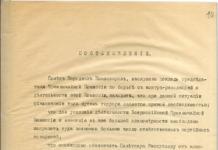What is a physical field? Is it possible to visualize it using simple images that are accessible to our understanding? How does it relate to ideas about particles of matter?
The simplest idea of a field is given by a continuous medium, for example water, filling a certain area of space (or all of space). This medium may have different densities or temperatures at different points, for example, and move differently. It is a specific physical property of the medium, different at different points and accessible for measurements, that physically determines the field. In this regard, a temperature field, a velocity field, a force field, etc. are distinguished.
In philosophical terms, the division of the world into bodies and particles, on the one hand, and a continuous medium, field and empty space, on the other, corresponds to the identification of two extreme properties of the world - its discreteness and continuity.
Discreteness means “granularity,” the final divisibility of the spatio-temporal structure and state of an object or object, its properties and forms of movement (jumps), while continuity expresses the unity, integrity and indivisibility of the object, the very fact of its stable existence. For the continuous there are no boundaries of the divisible.
In mathematics, these philosophical categories correspond to a discrete set of natural numbers and a continuous set (continuum) of real numbers. For an accurate spatiotemporal description of the properties of a continuous medium (and field), a special branch of mathematics was developed.
Discrete and continuous properties of the world within the framework of classical physics initially appear as opposite to each other, separate and independent from each other, although in general they complement the general idea of the world. And only the development of the field concept, mainly to describe electromagnetic phenomena, made it possible to understand their dialectical unity. In modern quantum theory, this unity of the opposites of discrete and continuous has found a deeper physical and mathematical justification in the concept wave-particle duality.
After the advent of quantum field theory, the idea of interaction changed significantly. According to this theory, any field is not continuous, but has a discrete structure. For example, electromagnetic interaction in quantum field theory is the result of particle exchange photons– quanta of the electromagnetic field, i.e. photons are carriers of this field. Similarly, other types of interaction arise as a result of the exchange of particles by quanta of the corresponding fields. For example, gravitons are assumed to take part in gravitational interaction (their existence has not yet been experimentally confirmed).
According to the field concept, the particles participating in the interaction create a special state at each point of the space surrounding them - a field of forces, manifested in the force influence on other particles placed at some point in this space. Initially, a mechanical interpretation of the field was put forward as elastic stresses of the hypothetical medium of the “ether”. The theory of relativity, having rejected the “ether” as a special elastic medium, at the same time gave a fundamental meaning to the concept of a field as a primary physical reality.
In modern quantum physics, a new possible type of matter can claim the role of “ether” - physical vacuum. The first ideas about it were given by one of the creators of quantum field theory, the English physicist P. Dirac (the so-called “Dirac sea”). Although we do not directly see the vacuum (it is transparent to electromagnetic radiation and does not offer any resistance to the movement of material particles and bodies), it can still appear when the same particles or electromagnetic waves (gamma quanta) that have sufficient energy interact with it. If this energy exceeds twice the rest energy of, for example, an electron, then the gamma quantum, in the presence of another particle (atomic nucleus), can, having itself disappeared, give birth to an electron-positron pair, as if “torn out” of the vacuum. There is other evidence in favor of a physical vacuum.
In the history of physics over the past 300 years, at least four different concepts of “ether” have been proposed: Newton’s absolute space, Huygens’ luminiferous ether, Einstein’s gravitational ether, and Dirac’s physical vacuum. Only the future will show to what extent physicists' intuition about the existence of a special medium in nature - a physical vacuum - will be justified.
When the researcher reaches the stage
on which he ceases to see behind
tree-lined forest, he too willingly
tends to resolve this difficulty
by moving on to study individual leaves.
Lancet
What are corpuscular and continuum approaches to describing various natural objects? What is a field in the broad sense of the word? To describe which objects the concept of field is used? How can you visualize a field?
Lesson-lecture
Corpuscular and continuum description of natural objects. Since ancient times, there have been two opposing ideas about the structure of the material world. One of them - the continuum concept of Anaxagoras-Aristotle - was based on the idea of continuity, internal homogeneity. Matter, according to this concept, can be divided indefinitely, and this is a criterion for its continuity. Filling the entire space entirely, matter “leaves no emptiness inside itself.”
Another idea - the atomistic, or corpuscular, concept of Leucippus-Democritus - was based on the discreteness of the space-time structure of matter. It reflected man’s confidence in the possibility of dividing material objects into parts up to a certain limit - down to atoms, which in their infinite diversity (in size, shape, order) are combined in various ways and give rise to the whole variety of objects and phenomena of the real world. With this approach, a necessary condition for the movement and combination of real atoms is the existence of empty space. Thus, the corpuscular world of Leucippus - Democritus is formed by two fundamental principles - atoms and emptiness, and matter has an atomic structure.
I look at him and don’t see him, and therefore I call him invisible. I listen to it and don’t hear it, and therefore I call it inaudible. I try to grab it and can't reach it, so I call it the smallest. There is no need to strive to find out the source of this, because it is one.
What do you think is the link between the image in the painting, the quote, and the title of the paragraph?
Paul Signac. Pine. Saint Tropez
Modern ideas about the nature of the microworld combine both concepts.
System as a collection of particles (corpuscular description). How can we describe the world of discrete particles based on classical concepts?
Let's look at the solar system as an example. In the simplest model, when the planets are considered as material points, for the description it is enough to specify the coordinates of all the planets. A set of coordinates in a certain reference system is denoted as follows: (x 1 (t), y 1 (t), z 1 (t)); here the index i numbers the planets, and the parameter t denotes the dependence of these coordinates on time. Setting all coordinates as a function of time completely determines the configuration of the planets of the Solar System at any given time.
If we want to refine our description, we need to specify additional parameters, such as the radii of the planets, their masses, etc. The more accurately we want to describe the Solar System, the more different parameters we must consider for each planet.
When describing a discrete (corpuscular) system, it is necessary to set various parameters that characterize each of the components of the system. If these parameters depend on time, this dependence must be taken into account.
System as a continuous object (continuum description). Turning to the epigraph at the beginning of the paragraph, let us now consider a system such as a forest. However, in order to characterize the forest, it is rather pointless to list all representatives of the flora and fauna of a given forest. And not just because it is too tedious, if not impossible, a task. Wood harvesters, mushroom pickers, military personnel, and ecologists are interested in different information. How to build an adequate model for describing this system?
For example, the interests of loggers can be taken into account by considering the average amount (in m 3) of commercial timber per square kilometer of forest in a given area. Let's denote this quantity by M. Since it depends on the area that is being considered, we introduce the x and y coordinates that characterize the area, and denote the dependence of M on the coordinates as a function of M(x,y). Finally, the value of M depends on time (some trees grow, others rot, fires occur, etc.). Therefore, for a complete description it is necessary to know the dependence of this quantity on time M(x,y,t). Then the values can be realistically, albeit approximately, estimated based on observation of the forest.
Let's give another example. Water flow is the mechanical movement of water particles and impurities. However, it is simply impossible to describe the flow using the corpuscular method: one liter of water contains more than 10 25 molecules. In order to characterize the flow of water at different points in the water area, it is necessary to know the speed at which water particles move at a given point, i.e. the function v(x, y, z, t) (The variable t means that the speed can depend on time , for example when the water level rises during a flood.)

Rice. 11. Fragment of a topographic map showing: lines of equal heights (a); image of hills and depressions (b)
A visual representation of the vector field can also be found on a geographic map - these are current lines that correspond to the fluid velocity field. The speed of a particle of water is always directed tangentially to such a line. Other fields are depicted with similar lines.
Such a description is called a field description, and a function that defines some characteristic of an extended object depending on coordinates and time is called a field. In the above examples, the function M(x, y, t) is a scalar field characterizing the density of industrial wood in the forest, and the function v(x, y, z, t) is a vector field characterizing the speed of fluid flow. There are a great many different fields. In fact, by describing any extended object as something continuous, you can introduce your own field, and more than one.
For a continuous (continuous) description of some extended object, the concept of field is used. A field is some characteristic of an object, expressed as a function of coordinates and time.
Visual representation of the field. When describing a system discretely, a visual representation does not cause difficulties. An example would be the familiar diagram of the solar system. But how can you depict a field? Let us turn to the topographic map of the area (Fig. 11, a).
This map, among other things, shows lines of equal heights for hills and depressions (Figure 11.6).
This is one of the standard visual representations of a scalar field, in this case the field of height above sea level. Lines of equal heights, i.e. lines in space at which the field takes on the same value, are drawn at a certain interval.
The field can be visually depicted as lines in space. For a scalar field, lines are drawn through points at which the value of the field variable is constant (lines of constant field value). For a vector field, directed lines are drawn so that at each point on the line the vector corresponding to the field at a given point will be tangent to this line.
- Meteorological maps draw lines called isotherms and isobars. What fields do these lines correspond to?
- Imagine a real field - a field of wheat. Under the influence of the wind, the spikelets tilt, and at each point of the wheat field the slope of the spikelets is different. Create a field. that is, indicate a value that could describe the inclination of the spikelets in a wheat field. What field is this: scalar or vector?
- The planet Saturn has rings that appear solid when viewed from Earth, but are actually many tiny satellites moving in circular paths. In what cases is it advisable to use a discrete description for the rings of Saturn, and in what cases is it advisable to use a continuous one?
Is it possible to speed up or slow down time?
Do parallel realities exist?
Is it possible to instantly travel through time? Is clairvoyance possible?
UNIVERSAL SAMPLING
The development of science and technology goes from continuous (analog) to discrete, i.e. not continuous. What does this mean? And look around! All modern technology is digital! It does not work with continuous signals, but with their discrete, that is, individual, values converted into digital code. These individual signal values are stored in memory blocks of computers, digital cameras, video cameras, and mobile phones. If necessary, they are processed, and from them, according to special programs, continuous signals are created - sound, electrical, light, etc.
But just recently, in the middle and even in the second half of the twentieth century, digital technology was not so widespread. We used analog instruments that work with continuous signals. And no individual values of these signals were converted into digital code.
Discrete, digital technology is more accurate, more multifunctional, and uses memory blocks more efficiently than analog. This proves that man is on the right path in unraveling the plan of Nature or the Higher Mind.
Similar processes occurred in physics. It formed a separate branch of science - quantum physics. It is precisely this that studies individual, in other words, discrete (again discretization, as in technology!) portions of matter and energy, in other words, quanta.
What is quantization (or, what is the same thing, discretization) of a process? The process is not considered continuously, but at some moments (time quantization) or in certain specific states (level quantization). Here I will show you in the picture:
Therefore, quantum physics considers everything discrete - individual particles, individual portions, quanta, substances, individual values of quantities, individual, that is, discrete, realities. Max Planck started this whole thing. It was he who introduced the concept of quantum - an indivisible portion of any quantity. This concept is based on the idea that some physical quantities can only take certain values, that is, a physical quantity is quantized or takes on discrete values. Quantum physics studies a wide range of physical phenomena that are characterized by discrete action.
PARALLEL REALITIES
The discreteness and quantum nature of the world has practically already been proven. This means that it is quite possible to assume the existence of discrete, parallel realities and the possibility of a transition from one reality to another - the so-called quantum leap. For example, I was in one reality - and hop! - moved to another. Everything is ultimately broken down into particles, that is, into discrete elements that do not intersect with each other. And realities exist discretely, parallel to each other. Well, like pages in a closed book. And therefore, you can move from one page-reality to another in a jump (after all, there is nothing between them, so the process of transition from one reality to another cannot be continuous, it is discrete).
One can assume the discrete nature of even our lives. Have you ever felt that, for example, your childhood was different, not your life? Have you ever experienced such a feeling that your life has moved to a new qualitative level? Personally, I have had such feelings many times. The process (a person’s life) had such and such a state, and suddenly it changed, jumping to another level. So much for sampling.
However, this is just a guess. But it is an assumption that allows us to admit and explain the existence of parallel realities. This means the possibility of instantly moving from one reality to another. It would be nice to move from a reality with a poor quality of life to a reality where the quality of life is better...
HOW TO EXPLAIN THIS?
It's no secret that everything, including humans, consists of tiny particles. Modern quantum physics is finding smaller and smaller particles. It has gotten to the point where even time is represented in the form of tiny particles - chronons. According to Professor Veinik's theory, every object consists of chronons. Each such particle carries a chronal substance that characterizes time. Somewhere there are more such particles, somewhere less. And it is possible that the amount of chronal substance in different chronons is different. Due to this, time heterogeneity arises. That is why, in my opinion, it happens that time flows in different ways: sometimes it drags on, sometimes it flies by quickly.
And there are particles that do not contain chronal substance at all, and therefore are “simultaneously present” in the past, present, and future. What does this give us?
First, an explanation for the instantaneous dissemination of information and for some people to gain access to information from the past and future.
Secondly, of course, the possibility of instant time travel! It turns out that if we consist of tiny particles (and this is the case), much smaller than, for example, an atom, say, of chronons present simultaneously in the present, and in the past, and in the future, then we ourselves at the same time We are present in the present, in the past, and in the future. Why don't we notice this? Well, maybe some kind of rearrangement of these particles that we are made of is needed for us to experience time travel. Perhaps it is necessary to first split the body into the smallest particles (and they exist in the present, and in the past, and in the future), and then assemble them - in the past or in the future. Or even in another reality, in another dimension. This is how travel in time and to other realities can be carried out.
Thus, thirdly, the existence of chronons suggests the existence of parallel realities and the possibility of movement between them. After all, if there are tiny particles that are devoid of chronal matter and are simultaneously present in the present, the past, and the future, then it turns out that the present, the past, and the future exist simultaneously, that is, in parallel and represent parallel realities. At a given moment in time, you can exist both in the present, and in the past, and in the future. Is it hard to imagine? But we don’t see all these tiny particles that make up us and our reality! So where is the guarantee that an infinite number of parallel realities, consisting of tiny particles of different sizes and located with different densities, do not exist right there and at the same moment? It is difficult for us to imagine, to visualize, only because we do not observe these smallest particles. But they exist!
INFORMATION TRAVELS
The above operations with the smallest particles can be defined as information processes that take place as a result of information influence. The fact is that this is generally a property of informational influence - to influence not the big, but the small, the smallest particles that make up a living object and with a change in the movement and state of which global qualitative changes in the body begin. Treatment with information methods, for example, is based on this property of information.
By the way, modern scientists have already learned to transfer the smallest particles for a fraction of a second in time and instantly move them over long distances in space - teleport. In this case, it is not the physical particle that moves, but information about it. When moving in time and from reality to reality by splitting into particles without chronal matter and reassembling, an object can also be obtained in another time or in another reality that is not physically exactly the same as the original one. But the main thing will move - information about the object, the information portrait of the object - all information related to it.
What is our personality? This is information! You have changed your body, for example, you have lost weight or gained weight, but you are you. And you are alive with any body. But if your information portrait, your psyche, the contents of your brain perish, this will be the destruction of your personality. Now a lot of rich people are trying to ensure eternal life for themselves by storing in memory blocks all the information that relates to them - all their thoughts, feelings, what they saw, heard, felt. For immortality, and indeed for the existence of a person, the main thing is to preserve information about oneself, and not the body. So, Professor Veinik’s theory allows us to assume the possibility of information movement from reality to reality and time travel and explain these phenomena.
Since ancient times, there have been two opposing ideas about the structure of the material world. One of them: the continuum concept of Anaxagoras - Aristotle - was based on the idea of continuity, internal homogeneity, “continuity” and, apparently, was associated with direct sensory impressions produced by water, air, light, etc. Matter, according to this concept, can be divided indefinitely, and this is a criterion for its continuity. Filling the entire space entirely, matter leaves no emptiness inside itself.
Another idea: the atomistic (corpuscular) concept of Leucippus - Democritus - was based on the discreteness of the spatio-temporal structure of matter, the “granularity” of real objects and reflected human confidence in the possibility of dividing material objects into parts only to a certain limit - to atoms, which in their infinite diversity (in size, shape, order) are combined in various ways and give rise to the whole variety of objects and phenomena of the real world. With this approach, a necessary condition for the movement and combination of real atoms is the existence of empty space. It must be admitted that the corpuscular approach has turned out to be extremely fruitful in various fields of natural science. First of all, this, of course, relates to Newtonian mechanics of material points. The molecular-kinetic theory of matter, based on corpuscular concepts, within the framework of which the laws of thermodynamics were interpreted, also turned out to be very effective. True, the mechanistic approach in its pure form turned out to be inapplicable here, since even a modern computer cannot trace the movement of 1023 material points located in one mole of matter. However, if we are interested only in the averaged contribution of chaotically moving material points to directly measured macroscopic quantities (for example, gas pressure on the wall of a vessel), then excellent agreement between theoretical and experimental results was obtained. The laws of quantum mechanics form the basis for the study of the structure of matter. They made it possible to clarify the structure of atoms, establish the nature of chemical bonds, explain the periodic system of elements, understand the structure of atomic nuclei, and study the properties of elementary particles. Since the properties of macroscopic bodies are determined by the movement and interaction of the particles of which they are composed, the laws of quantum mechanics underlie the understanding of most macroscopic phenomena. K.m. allowed, for example, to explain the temperature dependence and calculate the heat capacity of gases and solids, determine the structure and understand many properties of solids (metals, dielectrics, semiconductors). Only on the basis of quantum mechanics was it possible to consistently explain such phenomena as ferromagnetism, superfluidity, and superconductivity, to understand the nature of such astrophysical objects as white dwarfs and neutron stars, and to elucidate the mechanism of thermonuclear reactions in the Sun and stars.
In quantum mechanics, a fairly common situation is when an observable has a pair observable. For example, impulse is coordinate, energy is time. Such observables are called complementary or conjugate. The Heisenberg uncertainty principle applies to all of them.
There are several different equivalent mathematical descriptions of quantum mechanics:
Using Schrödinger's equation;
Using von Neumann operator equations and Lindblad equations;
Using Heisenberg operator equations;
Using the secondary quantization method;
Using path integral;
Using operator algebras, the so-called algebraic formulation;
Using quantum logic.
When the researcher reaches the stage
on which he ceases to see behind
tree-lined forest, he too willingly
is inclined to resolve this
difficulties by moving on to study
individual leaves.
Corpuscular and continuum approaches to the description of nature. Scalar field. Vector field. Trajectory.
Corpuscular and continuum description of natural objects. You know about the atomic and molecular structure of matter. This knowledge is based on experimental facts. It was experience, in particular Perrin’s experience in studying Brownian motion, that put an end to the debate among philosophers about whether matter is discrete or continuous.
Since ancient times, there have been two opposing ideas about the structure of the material world. One of them - the continuum concept of Anaxogoras - Aristotle - was based on the idea of continuity, internal homogeneity, “continuity” and, apparently, was associated with direct “sensory” impressions produced by water, air, light, etc. Matter according to this concept can be divided ad infinitum, and this is the criterion of its continuity. Filling the entire space entirely, matter “leaves no emptiness inside itself.”
Another idea - the atomistic, otherwise corpuscular concept of Leucippus - Democritus - was based on the discreteness of the spatio-temporal structure of matter, the “granularity” of real objects and reflected human confidence in the possibility of dividing material objects into parts up to a certain limit - atoms, which in their infinite diversity ( by size, shape, order) are combined in various ways and give rise to the whole variety of objects and phenomena of the real world. With this approach, a necessary condition for the movement and combination of real atoms is the existence of empty space. Thus, the corpuscular world of Leucippus - Democritus is formed by two fundamental principles - atoms and emptiness, and matter has an atomic structure. Atoms, according to the ancient Greeks, neither arise nor are destroyed; their eternity stems from the infinity of time.
Modern ideas about the nature of the microworld combine both concepts. On the one hand, our world really consists of individual particles, i.e., what the ancient Greeks called atoms. The number of these particles in the Universe we observe is finite, although very large. On the other hand, there is no emptiness in the space we observe, since, for example, such components of matter as photons are not spatially separated and, having the properties of continuity, completely fill it.
A system as a collection of particles (corpuscular description). Before talking about the continuum approach, let us recall how the world of discrete particles can be described on the basis of classical concepts.
Let's take the Solar System as an example. In the simplest model, when the planets are considered as material points, for the description it is enough to specify the coordinates of all the planets. A set of coordinates in a certain reference system is denoted as follows: ( x i (t), y i (t), z i (t)), here is the index i numbers the planets, and the parameter t denotes the dependence of these coordinates on time. Setting all coordinates as a function of time completely determines the configuration of the planets of the Solar System at any given time.
If we want to clarify our description, it is necessary to specify additional parameters, for example, the radii of the planets, their masses, etc. The more accurately we want to describe the Solar System, the more different parameters for each of the planets we must consider.
Thus, with a discrete (corpuscular) description of a certain system, it is necessary to set various parameters that characterize each of the components of the system. If these parameters depend on time, this dependence must be taken into account.
System as a continuous object (continuous description). Turning to the epigraph, let us now consider a system such as a forest. However, in order to characterize the forest, it is rather pointless to list all representatives of the flora and fauna of a given forest. And not just because it is too tedious, if not impossible, a task. Wood harvesters, mushroom pickers, military personnel, and ecologists are interested in different information. How to build an adequate model for describing this system?
For example, the interests of loggers can be taken into account by considering the average amount (in cubic meters) of commercial timber per square kilometer of forest in a given area. Let us denote this quantity by M. Since it depends on the area being considered, we enter the coordinates x And y, characterizing the area and denote the dependence M from coordinates as a function M(x,y). Finally, the magnitude M depends on time (some trees grow, others rot, fires occur, etc.). Therefore, for a complete description it is necessary to know the dependence of this quantity on time M(x,y,t). Then the values can be realistically, albeit approximately, estimated based on observations of the forest.
Field
Gravitational field. Let's remember the physics course. You studied the law of universal gravitation, according to which all bodies attract each other with a force proportional to the product of their masses and inversely proportional to the square of the distance between them.
Let us consider any of the bodies of the Solar System and denote its mass by m. In accordance with the law of universal gravitation, all other bodies of the Solar System act on this body, and the total gravitational force, which we denote by , is equal to the vector sum of all these forces. Since each of the forces is proportional to the mass m, then the total force can be represented as: . The vector quantity depends on the distance to other bodies of the Solar System, i.e., on the coordinates of the body we have chosen. From the definition given in the previous paragraph, it follows that the quantity is a field. This field is called the gravitational field.
Near the surface of the Earth, the force exerted by the Earth on a body, such as you, far exceeds all other gravitational forces. This is the force of gravity you are familiar with. Since the force of gravity is related to the mass of a body by the relation , then near the surface of the Earth there is simply an acceleration of gravity.
Since the value does not depend on the mass or any other parameter of the body we have chosen, it is obvious that if another body is placed at the same point in space, then the force acting on it will be determined by the same value multiplied by the mass of the new one bodies. Thus, the action of the gravitational forces of all bodies of the Solar System on a certain test body can be described as the action of a gravitational field on this test body. The word trial means that this body may not exist, the field at a given point in space still exists and does not depend on the presence of this body. The test body simply serves to enable this field to be measured by measuring the total gravitational force acting on it.
It is quite obvious that in our discussions we can not limit ourselves to the Solar system; we can consider any system of bodies, no matter how large.
The gravitational force created by a certain system of bodies and acting on the test body can be represented as the action of the gravitational field created by all bodies (except for the test body) on the test body.
Electromagnetic field. Electrical forces are very similar to gravitational forces, only they act between charged particles, and for like-charged particles they are repulsive forces, and for unlike-charged particles they are attractive forces. A law similar to the law of universal gravitation is Coulomb's law. According to it, the force acting between two charged bodies is proportional to the product of the charges and inversely proportional to the square of the distance between the bodies.
Due to the analogy between Coulomb's law and the law of universal gravitation, what was said about gravitational forces can be repeated for electrical forces, and we can imagine the force acting on the test charge from a certain system of charged bodies q as: . The quantity characterizes the electric field you are familiar with and is called the electric field strength. The conclusion regarding the gravitational field can be repeated almost verbatim for the electric field.
The electric force created by some system of charged bodies and acting on the test charge can be represented as the action of the electric field created by all charged bodies (except for the test) on the test charge.
The interaction between charged bodies (or simply charges), as already mentioned, is very similar to the gravitational interaction between any bodies. However, there is one very significant difference. Gravitational forces do not depend on whether bodies are moving or stationary. But the force of interaction between charges changes if the charges move. For example, repulsive forces act between two identical stationary charges. If these charges move, then the interaction forces change. In addition to electrical repulsive forces, attractive forces appear.
You are already familiar with this force from your physics course. It is this force that causes the attraction of two parallel current-carrying conductors. This force is called magnetic force. Indeed, in parallel conductors with identically directed currents, charges move as shown in the figure, which means they are attracted by a magnetic force. The force acting between two current-carrying conductors is simply the sum of all the forces acting between the charges. Why does the electric force disappear in this case?
Everything is very simple. Conductors contain both positive and negative charges, and the number of positive charges is exactly equal to the number of negative charges. Therefore, in general, the electrical forces are compensated. Currents arise due to the movement of only negative charges; positive charges in the conductor are stationary. Therefore, magnetic forces are not compensated.
Mechanical motion is always relative, that is, the speed is always given relative to some reference system and changes when moving from one reference system to another.
Now look carefully at Figure 21. How do the drawings differ? A And b? In the second picture, the charges are moving. But this movement is only in a certain frame of reference chosen by us. We can choose a different frame of reference in which both charges are stationary. And then the magnetic force disappears. This suggests that electric and magnetic forces are forces of the same nature. And indeed it is. Experience shows that there is a single electromagnetic force acting between charges, which manifests itself differently in different reference systems. Accordingly, we can talk about a single electromagnetic field, which is a combination of two fields - an electric field and a magnetic field. In different reference systems, the electric and magnetic components of the electromagnetic field can manifest themselves in different ways. In particular, it may turn out that in some reference system the electric or magnetic component of the electromagnetic field disappears. Thus, from the relativity of motion it follows that electrical interaction and magnetic interaction are two components of a single electromagnetic interaction.
But, if so, then we can repeat the conclusion regarding the electric field.
The electromagnetic force created by a certain system of charges and acting on the test charge can be represented as the action of the electromagnetic field created by all charges (except for the test charge) on the test charge.
One should not think that only gravitational and electromagnetic interactions can be expressed through the corresponding field. The method of describing interaction using fields has found wide application in the physics of the microworld. This method can be used to describe a wide variety of interactions. For example, the Archimedean force acting on a body immersed in a liquid, or on a balloon in the air, is expressed as follows: F A = r gV, Where g- acceleration of gravity, V is the volume of a body immersed in a liquid or in air, аr is the density of the liquid or air. As is known, air density decreases with height, i.e. it depends on the coordinates. The density of water also changes with depth; in the ocean depths the density of water is slightly greater than near the surface of the ocean. It follows that the density depends on the coordinates of the body under the influence of the Archimedean force. That is, you can introduce a density field, which, when acting on a body, leads to the emergence of the Archimedes force.
Another example is related to the forces acting on a body streamlined by a flow of liquid or gas. These forces include the force of resistance to movement in a water or gaseous environment, and the lift force acting on the wing of an aircraft. The flow of liquid or gas is a velocity field (see previous paragraph). This field affects every part of the surface of the body in the flow, which leads to the emergence of drag and lift forces.
The general conclusion that can be drawn based on the examples discussed in this paragraph: many forces acting on a body located in a vacuum or in a continuous medium can be represented as a result of the action of the corresponding fields on the body. Such forces include, in particular, gravitational and electromagnetic forces.


















